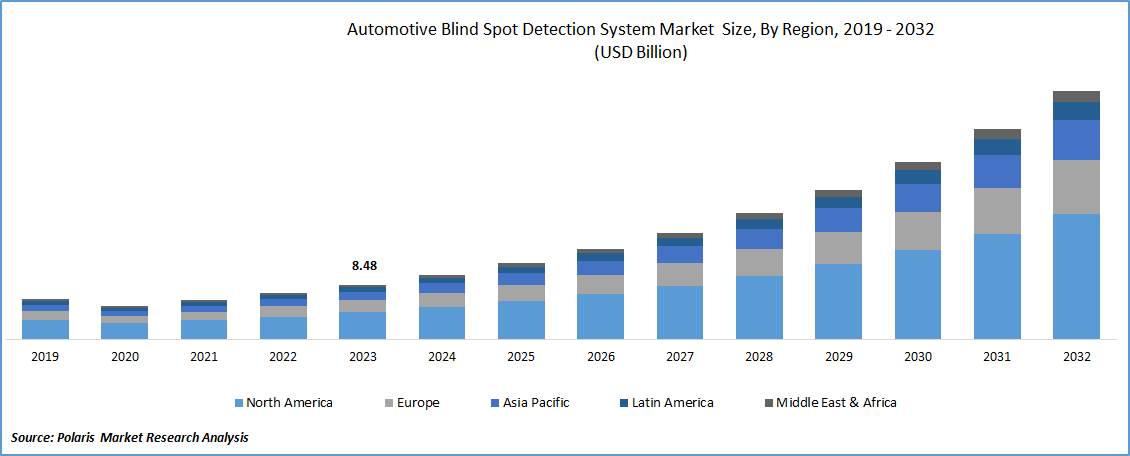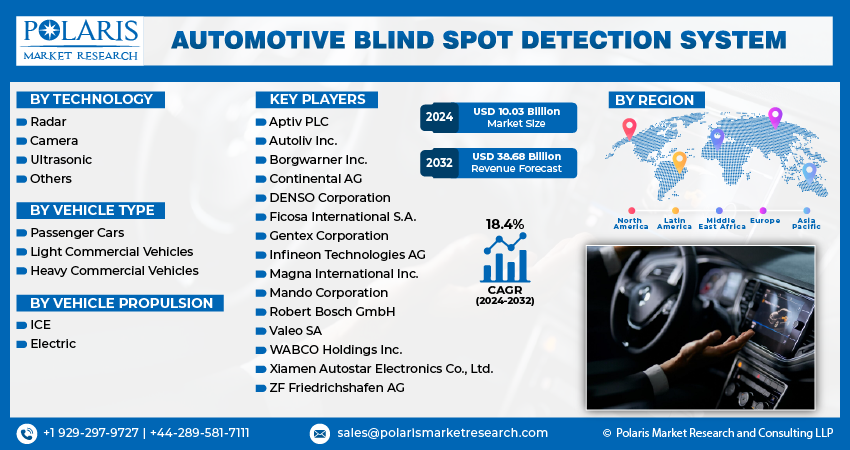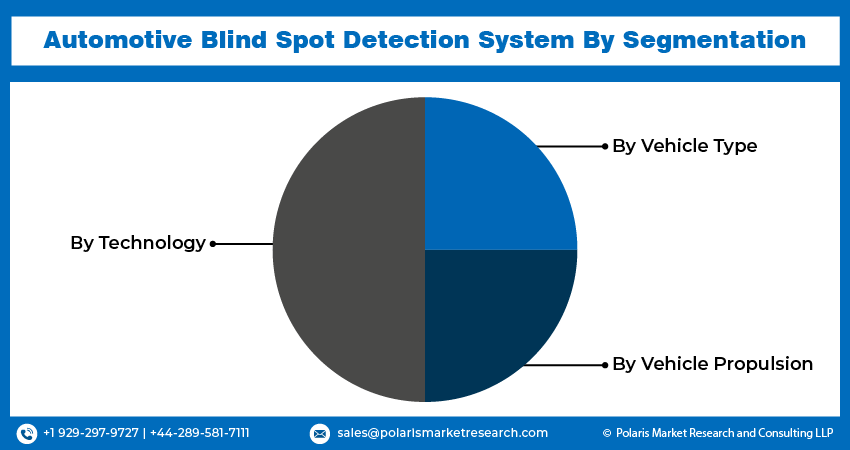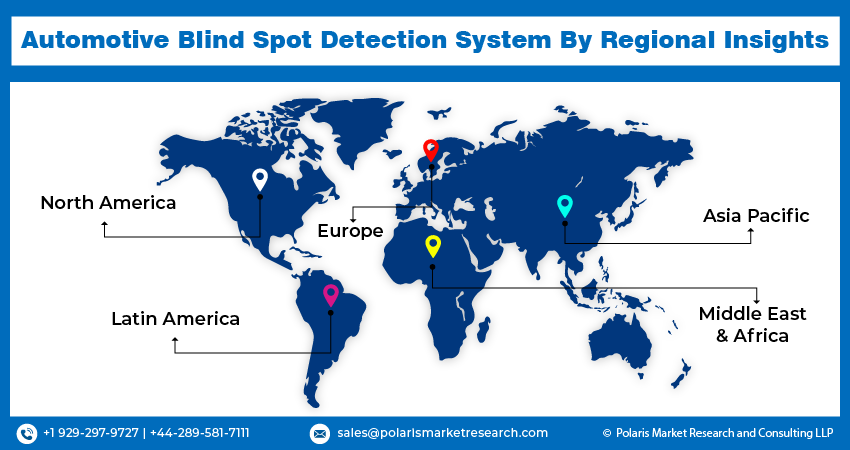
Automotive Blind Spot Detection System Market Share, Size, Trends & Industry Analysis Report
By Technology (Radar, Camera, Ultrasonic, Others); By Vehicle Type; By Vehicle Propulsion; By Region; Segment Forecast, 2025 - 2034
- Published Date:Jun-2025
- Pages: 119
- Format: PDF
- Report ID: PM4367
- Base Year: 2024
- Historical Data: 2020-2023
The global Automotive Blind Spot Detection Market was valued at USD 3.84 billion in 2024 and is projected to grow at a CAGR of 8.5% from 2025 to 2034. Increasing focus on vehicle safety systems and ADAS integration is boosting market growth.
The automotive blind spot detection system market sees significant expansion as consumer awareness and preference for advanced safety technologies surge. Informed and safety-conscious consumers increasingly prioritize vehicles equipped with cutting-edge features like blind spot detection systems. Heightened awareness of the risks associated with blind spots during lane changes fosters a preference for vehicles offering enhanced safety. This consumer-driven demand propels automakers to integrate blind spot detection systems, meeting the expectations of the market.
In addition, companies operating in the market are introducing new solutions to strengthen market presence.

To Understand More About this Research: Request a Free Sample Report
- For instance, in October 2023, Sensata Technologies unveiled the PreView Sentry79, a radar system designed for take-off and reverse blind spot monitoring. Incorporating state-of-the-art technology, this release by Sensata Technologies establishes a new benchmark for detecting blind spots and preventing collisions in both on-road and off-road heavy vehicle sectors.
The automotive blind spot detection system market witnesses dynamic growth fueled by continuous technological innovations. The development of sophisticated blind spot detection systems is fueled by advancements in sensor technology, including cameras, lidar, and radar. These developments improve the systems' overall performance and accuracy of detection by increasing their efficiency and dependability. Manufacturers present cutting-edge products that redefine safety requirements.
Industry Dynamics
Growth Drivers
Elevated Road Safety Prioritization and Mandatory Compliance with Stringent Safety Standards
The automotive blind spot detection system market is experiencing accelerated growth due to an elevated emphasis on road safety. Governments, regulatory bodies, and consumers increasingly prioritize accident prevention, making blind spot detection systems a pivotal solution. With a heightened awareness of the risks associated with blind spots during lane changes, the market responds to the urgent need for proactive safety measures. This road safety prioritization is a driving force, compelling automakers to integrate advanced blind spot detection systems, ensuring enhanced situational awareness and mitigating collision risks. The market's upward trajectory aligns with the collective commitment to fostering a safer driving environment.
The automotive blind spot detection system market experiences substantial growth propelled by mandatory compliance with stringent safety standards. Regulatory bodies globally impose rigorous safety mandates on vehicle manufacturers, compelling them to integrate advanced safety technologies. Blind spot detection systems emerge as a pivotal solution to meet these demanding standards, ensuring vehicles adhere to robust safety benchmarks. As automakers strive to meet regulatory requirements, the market witnesses increased integration of these systems, underscoring their significance in elevating vehicle safety.

Report Segmentation
The market is primarily segmented based on technology, vehicle type, vehicle propulsion, and region.
|
By Technology |
By Vehicle Type |
By Vehicle Propulsion |
By Region |
|
|
|
|
To Understand the Scope of this Report: Speak to Analyst
By Technology Analysis
The radar segment accounted for a significant market share in 2024
In 2023, the radar segment accounted for a significant market share. Radar technology is integral to the automotive blind spot detection system, providing a spectrum of capabilities for heightened safety and awareness. The sophisticated Frequency Modulated Continuous Wave (FMCW) radar ensures precise range measurements within blind spots. Excelling in long-range detection, radar significantly elevates drivers' situational awareness. Resilient in adverse weather conditions, radar penetrates obstacles and operates consistently. Advanced radar systems offer multi-object tracking, discerning between objects and providing insights into dynamic traffic behavior. Determining speed and direction, radar aids in predicting potential collisions and enables effective collision avoidance. Collaborating seamlessly with other sensors, radar ensures comprehensive coverage. Precision minimizes false alarms, and compact integration complements vehicle design. High resolution allows detailed object discrimination, and cross-traffic alert capabilities enhance safety at intersections. In essence, radar technology is fundamental to enhancing safety features and advancing vehicle safety.
By Vehicle Type Analysis
The passenger cars segment accounted for the largest market share in 2024
In 2023, the passenger cars segment accounted for the largest market share. The integration of automotive blind spot detection systems in passenger cars signifies a pivotal advancement in vehicular safety. Tailored for urban settings; these systems navigate intricate traffic patterns, mitigate collision risks during turns, and enhance safety on highways with informed overtaking decisions. During parking, the system prevents collisions, prioritizing safety in low-speed maneuvers. Its contribution to pedestrian and cyclist safety, real-time alerts, and seamless integration with driver assistance systems make it indispensable. User-friendly interfaces, a compact design, and adaptability across models ensure accessibility. Cross-traffic alert and weather resilience further underscore its versatility, emphasizing its crucial role in preventing side-impact collisions for a safer driving experience.
By Vehicle Propulsion Analysis
The electric segment is expected to experience significant growth during the forecast period
The electric segment is expected to experience significant growth during the forecast period. The integration of automotive blind spot detection systems in electric vehicles (EVs) is a crucial safety advancement. As EVs operate silently, the systems compensate for reduced audible cues, prioritizing pedestrian and cyclist safety. Offering enhanced situational awareness during maneuvers, these systems seamlessly integrate with EV architecture, ensuring precise monitoring. They optimize energy efficiency without compromising safety, aligning with the goals of autonomous driving. Beyond vehicle-to-vehicle monitoring, the technology significantly contributes to pedestrian and cyclist safety. Customized alerts cater to EV drivers' unique needs, while user interfaces provide an intuitive experience. Safety extends to charging stations, promoting efficient range preservation and compliance with stringent regulations.

Regional Analysis
Asia-Pacific accounted for the largest revenue share in 2024
In 2023, Asia-Pacific accounted for the largest revenue share. The growing trend of rising automotive sales is driving the market for automotive blind spot detection systems. Owing to rising disposable incomes and urbanization, enhanced safety features are becoming more and more important to consumers in Asia-Pacific, where car sales are surging. Modern cars are now completely built with blind spot detection systems, which provide increased safety and accident prevention. Sophisticated technologies like blind spot detection systems have to be integrated since governments in the regions have introduced mandates. Blind spot detection systems are widely used to make sure cars satisfy safety standards because of the strict compliance requirements.
The European automotive blind spot detection system market thrives on a dynamic landscape shaped by stringent safety standards, heightened consumer awareness, and proactive government support for innovation. With a focus on technological advancements, premium vehicle segment growth, and collaborations, the market witnesses a robust evolution. The integration of blind spot detection systems with autonomous driving technologies addresses urban traffic challenges and cross-border complexities and aligns with environmental considerations. Beyond new vehicle sales, the market extends its reach through aftermarket solutions, retrofitting existing vehicles, and contributing significantly to pedestrian safety. This comprehensive approach defines the market's trajectory, emphasizing safety, innovation, and adaptability.

Key Market Players & Competitive Insight
The market faces fierce rivalry, with companies leveraging cutting-edge technology, top-notch product offerings, and a robust brand reputation to propel revenue expansion. Key players employ diverse tactics, including dedicated research and development, strategic mergers and acquisitions, and continuous technological advancements. These strategic maneuvers are aimed at broadening their product ranges and sustaining a competitive advantage. The market dynamic is shaped by constant innovation and a commitment to delivering high-quality solutions, underscoring the importance of strategic initiatives in ensuring sustained competitiveness.
Some of the major players operating in the global market include:
- Aptiv PLC
- Autoliv Inc.
- Borgwarner Inc.
- Continental AG
- DENSO Corporation
- Ficosa International S.A.
- Gentex Corporation
- Infineon Technologies AG
- Magna International Inc.
- Mando Corporation
- Robert Bosch GmbH
- Valeo SA
- WABCO Holdings Inc.
- Xiamen Autostar Electronics Co., Ltd.
- ZF Friedrichshafen AG
Recent Developments
- In November 2023, Honda Motor Co., Ltd. revealed its latest Honda SENSING 360+, a comprehensive safety and driver-assistive system that eliminates blind spots, enhancing collision avoidance and alleviating driver workload during travel.
- In January 2022, Texas Instruments revealed an extension of its automotive solutions aimed at enhancing the sensing capabilities of advanced driver assistance systems. The introduction of TI's latest AWR2944 radar sensor equips automotive engineers with additional resources to drive innovation in vehicle technology. The heightened capacity for rapid object detection and blind spot monitoring significantly elevates safety standards in automobiles.
Automotive Blind Spot Detection System Market Report Scope
|
Report Attributes |
Details |
|
Market size value in 2025 |
USD 4.2 billion |
|
Revenue forecast in 2034 |
USD 9.08 billion |
|
CAGR |
8.50% from 2025 - 2034 |
|
Base year |
2024 |
|
Historical data |
2020 - 2023 |
|
Forecast period |
2025 - 2034 |
|
Quantitative units |
Revenue in USD billion and CAGR from 2025 to 2034 |
|
Segments covered |
By Technology, By Vehicle Type, By Vehicle Propulsion, By Region |
|
Regional scope |
North America, Europe, Asia Pacific, Latin America; Middle East & Africa |
|
Customization |
Report customization as per your requirements with respect to countries, region and segmentation. |
FAQ's
Borgwarner Inc., Continental AG, DENSO Corporation, Magna International Inc., Robert Bosch GmbH are the key companies in Automotive Blind Spot Detection System Market.
The global automotive blind spot detection system market is expected to grow at a CAGR of 18.4% during the forecast period.
The Automotive Blind Spot Detection System Market report covering key segments are technology, vehicle type, vehicle propulsion, and region.
Elevated Road Safety Prioritization are the key driving factors in Automotive Blind Spot Detection System Market.
The global automotive blind spot detection system market size is expected to reach USD 9.08 billion by 2034
